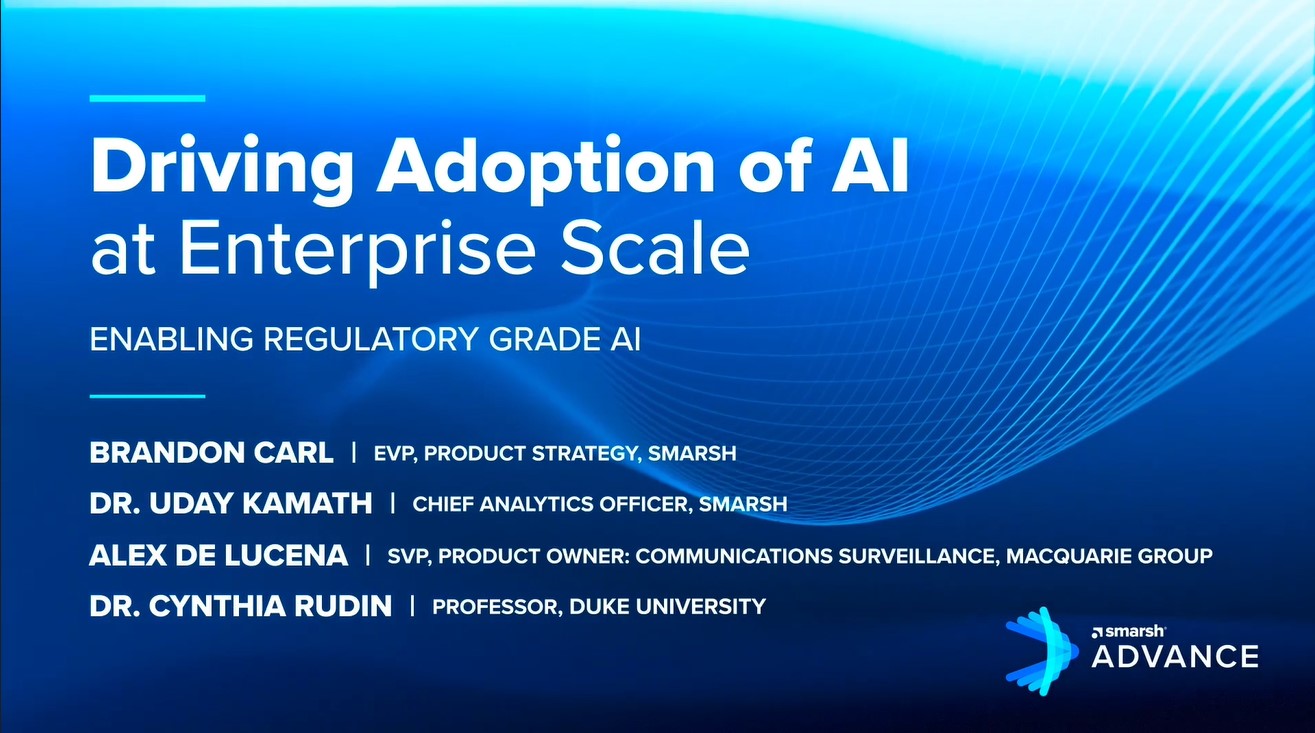More Than Meets the Eye: How AI Is Transforming Compliance
Changing market conditions, the pace of technology innovation and the explosive growth of new, heterogeneous data sources have led to a foregone conclusion: legacy archiving, discovery and supervisory systems are no longer suited for purpose. Compliance and risk management solutions must be as transformative as the world in which they operate.
Communications Intelligence is the transformation of traditional compliance and risk management from reactive and limited, to proactive, scalable and strategic.
One of the most transformative aspects of Communications Intelligence is the ability to harness today’s advances in artificial intelligence and natural language processing. The realities of the last couple years have led many firms to conclude that the explosion of content volume and variety are stretching the limits of human, manually intensive content inspection and review beyond their usefulness.
However, getting past small-scale trials and experiments in the use of AI/NLP is often hampered by one critical factor — the quality of the underlying dataset. Capturing and preserving the content, metadata and context of collaborative tools, mobile apps, voice recordings, and other non-textual information — on scalable public cloud infrastructure — builds the basis for unleashing the power of AI/NLP-powered applications.
We recently hosted a virtual event, Smarsh Advance, to discuss these changes and how to succeed in a data-heavy, hybrid working world. Sessions were divided into three tracks:
1. Collaborate
2. Protect
3. Transform
In the session “Driving Adoption of AI at Enterprise Scale,” the panel discussed “regulatory-grade AI,” which refers to artificial intelligence that is mission-critical and therefore must have higher degrees of scrutiny for use in applications such as digital communications compliance.
The session was moderated by Brandon Carl, Executive Vice President of Product Strategy at Smarsh, featuring Dr. Uday Kamath, Chief Analytics Officer at Smarsh, Dr. Cynthia Rudin, professor of computer science, electrical and computer engineering, statistical science, and biostatistics and bioinformatics at Duke University, and Alex de Lucena, Senior Vice President at Macquarie.
Panel participants also took a deeper dive into ranging technical approaches to AI, NLP, and machine learning. We recommend viewing this highly informative session from preeminent field experts on-demand.

What’s holding companies back from AI adoption
According to a McKinsey report on “The state of AI in 2021,” AI adoption is growing, with 56% of respondents reporting AI adoption in at least one function, up from 50% in 2020.
“From a high level, deploying AI requires thinking about the process, people and data,” Uday said.
Most proofs of concepts for AI, he said, never make it to production, partially because companies haven’t fully thought it out:
- Process: companies must have clarity about mapping business goals to the AI metrics or machine learning models
- People: it’s important to invest in resources and expertise, including stakeholders from across the organization, to decide who must be supervised and how that will be accomplished
- Data: there must be enough data to train AI models on what to look for, and this may take time
Alex de Lucena said data is of primary importance. “For a small bank, the question is, do you have enough data? If not, how do you supplement it? For a big bank, where do you focus first? Which communication channel, which departments or groups are you prioritizing? You need people who can train these models and who can speak to the risks baked into those models in a way that they can validate it. And you can actually zero in on what the specific behavior is you're looking to surface.”
He also said properly deploying AI models requires a fully baked strategy. “A lot of people enter into AI training models because there's been some fire — a regulator said you had to do something or a regulator recommended more broadly that people need to initiate this journey,” Alex continued. “So, they find a vendor and people and then have to decide the first step.”
Alex urged that companies expect AI models to work quickly, especially given legacy surveillance methods such as pre-configured lexicons, but it’s not that easy. You can’t avoid doing the work and allowing for time. “And then everything goes from there.”
AI adoption is growing, with 56% of respondents reporting AI adoption in at least one function, up from 50% in 2020. - McKinsey
The many uses for AI-powered communications analysis
Employee misconduct can be detrimental to an enterprise in many ways — regulatory violations, IP loss/data breaches, and harassment or prejudicial treatment. AI-powered analytics can help to understand human communications and behavior more deeply while also identifying critical insights within that data, including:
- Increased risk discovery: deep learning models identify new and emerging risks
- Reduced false positives/identify true positives more precisely
- Lower operating costs from disparate technologies and inefficient review processes
- Client insights to grow cross-selling opportunities
- Proactive management of legal, internal, cybersecurity, brand and privacy risks
What to look out for when choosing an AI vendor
Consider the process, people, and data that you’ll need first. To achieve data interpretability, you must document what you're doing as you go. Use an iterative approach with data — at the training level, at the validation level, and then in production, to show that you've accomplished the things that you set out to do.
Smarsh simplifies your communications technology stack to unlock the value within your communications.
- Capture over 100 communications channels in full fidelity
- Archive with multi-petabyte global scale
- Monitor all communications across languages and regions
- Streamline in-house investigations and e-discovery
- Analyze data to identify valuable business insights
- Take advantage of AI to understand and manage your data more clearly
The Smarsh Communications Intelligence platform is a single, cloud-native platform that scales to the size of the challenges you face. Unlock the signals in your communications and focus on what’s important to your business. This is Communications Intelligence.
This is the third blog in a series recapping our Smarsh Advance virtual event. In earlier posts, we discussed the importance of tools like Slack for hybrid work and how to adjust e-discovery to incorporate new digital communications.
Share this post!
Smarsh Blog
Our internal subject matter experts and our network of external industry experts are featured with insights into the technology and industry trends that affect your electronic communications compliance initiatives. Sign up to benefit from their deep understanding, tips and best practices regarding how your company can manage compliance risk while unlocking the business value of your communications data.







Subscribe to the Smarsh Blog Digest
Subscribe to receive a monthly digest of articles exploring regulatory updates, news, trends and best practices in electronic communications capture and archiving.
Smarsh handles information you submit to Smarsh in accordance with its Privacy Policy. By clicking "submit", you consent to Smarsh processing your information and storing it in accordance with the Privacy Policy and agree to receive communications from Smarsh and its third-party partners regarding products and services that may be of interest to you. You may withdraw your consent at any time by emailing privacy@smarsh.com.
FOLLOW US